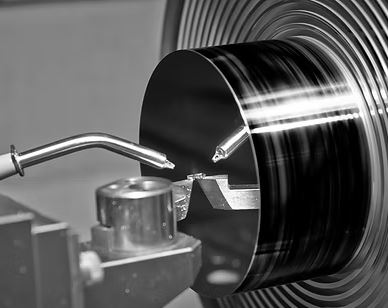


In the modern manufacturing industry, precision, efficiency, and superior surface quality are critical to maintaining competitiveness. One of the most demanding machining tasks is achieving a flawless mirror-like surface finish on hard and brittle materials such as single-crystal silicon, sapphire, ceramics, glass, and non-ferrous metals. Traditional tools often fall short when it comes to delivering the required precision and surface smoothness. This is where MCD cutting tools (Monocrystalline Diamond cutting tools) step in.
MCD cutting tools are manufactured from a single-crystal diamond material, providing unmatched sharpness, cutting stability, and surface finish quality. They are the ultimate choice for ultra-precision machining applications where mirror machining is essential, such as in the optical, semiconductor, aerospace, and high-end consumer electronics industries.
What is MCD?
MCD stands for Monocrystalline Diamond. It is a synthetic or natural single-crystal diamond material characterized by its:
* Perfect lattice structure without grain boundaries.
* Extreme hardness (the hardest known material in nature).
* Exceptional sharpness, since a single-crystal diamond edge can be sharpened to a nanoscale level.
* Outstanding wear resistance and ability to maintain tool geometry during ultra-precision machining.
Because MCD lacks internal grain boundaries (unlike PCD), it can be processed into an atomically sharp cutting edge, which makes it ideal for mirror-quality finishes and nanometer-level surface roughness.
What are MCD Cutting Tools?
MCD cutting tools are precision tools with cutting edges made of monocrystalline diamond. They are often fabricated using high-precision grinding and laser machining technologies to ensure superior edge sharpness and stability.
Key features of MCD cutting tools include:
Extremely sharp cutting edge radius (often less than 50 nm).
Ultra-smooth cutting surface without micro-chipping.
High thermal conductivity, preventing localized overheating.
Chemical inertness, making them resistant to reaction with most non-ferrous materials.
MCD tools are primarily used in applications requiring superfine surface quality, tight tolerances, and long tool life.
MCD cutting tools are designed for ultra-precision machining. Their primary applications include:
1. Optical Industry
Machining optical lenses, mirrors, and components made from glass, crystal, or polymers.
Producing freeform optics with nanometer-level precision.
Ensuring perfect transparency and minimal light scattering by achieving flawless surface finishes.
2. Semiconductor Industry
Cutting and shaping silicon wafers, sapphire substrates, and gallium arsenide (GaAs) materials.
Processing optical components used in semiconductors and photonics.
3. Consumer Electronics
Machining decorative surfaces of smartphones, watches, and high-end displays.
Producing ultra-smooth housings and components for luxury devices.
4. Aerospace and Defense
Manufacturing precision gyroscopes, navigation optics, and laser components.
Machining infrared windows and domes from sapphire or other hard materials.
5. Automotive Industry
High-precision machining of engine components requiring ultra-low surface roughness.
Processing molds for producing reflective automotive lights.
6. Molds and Dies
Machining precision molds for plastic injection, glass molding, and microelectronics.
Producing molds with mirror-quality finishes, reducing or eliminating polishing requirements.
Difference Between PCD, CBN, and MCD Cutting Tools
To better understand the unique benefits of MCD tools, it is important to compare them with PCD (Polycrystalline Diamond) and CBN (Cubic Boron Nitride) tools.
Feature | PCD (Polycrystalline Diamond) | CBN (Cubic Boron Nitride) | MCD (Monocrystalline Diamond) |
Material Structure | Polycrystalline (many small diamond grains bonded together) | Cubic form of boron nitride | Single-crystal diamond |
Hardness | Very high (but lower than MCD) | Slightly lower than diamond, excellent for hardened steels | Highest known hardness |
Edge Sharpness | Limited by grain size (0.5–30 µm) | Sharp, but not suitable for mirror finishes | Atomically sharp edge possible |
Surface Finish | Ra ≈ 0.05–0.1 µm | Ra ≈ 0.1–0.4 µm | Ra < 0.01 µm (mirror finish) |
Wear Resistance | High, but grain pull-out possible | Excellent for hard ferrous alloys | Exceptional for non-ferrous and brittle materials |
Best Applications | Non-ferrous metals, composites, high-speed machining | Hardened steels, superalloys | Ultra-precision machining, optics, semiconductors |
Cost | Moderate | Moderate to high | High |
From the table, it’s clear that PCD tools are widely used for general non-ferrous machining, CBN tools excel in hardened steel machining, while MCD tools dominate applications demanding atomic-level smoothness and mirror-quality surfaces.
Advantages of MCD Cutting Tools
MCD cutting tools provide unique advantages that make them irreplaceable in mirror machining applications:
1. Unparalleled Surface Finish
MCD edges can achieve surface roughness Ra < 0.01 µm, far beyond the capabilities of PCD and CBN tools.
This eliminates or reduces post-processing steps such as polishing or lapping.
2. Superior Edge Sharpness
Atomically sharp edges allow for precise cutting of brittle and delicate materials.
Ideal for machining glass, ceramics, and crystal without causing micro-cracks.
3. High Dimensional Accuracy
MCD tools maintain cutting-edge geometry for long durations, ensuring consistent dimensional accuracy in mass production.
4. Extended Tool Life
Excellent wear resistance, particularly in non-ferrous materials, reduces tool change frequency and increases productivity.
5. Reduced Tool-Induced Damage
Prevents subsurface damage, chipping, or cracks when machining brittle materials.
Ensures components maintain both functional and aesthetic integrity.
6. Efficiency and Cost Savings
Although MCD tools are expensive upfront, their ability to reduce polishing and rework, combined with longer tool life, often lowers overall production costs.
7. Versatility in Ultra-Precision Machining
Suitable for both turning and milling of hard-to-machine materials where optical or electronic performance depends on flawless surfaces.
Challenges and Considerations
Despite their advantages, MCD cutting tools also present certain challenges:
High Cost – MCD is expensive to produce and process.
Brittleness – The single-crystal structure can chip under excessive mechanical or thermal shock.
Limited to Non-Ferrous Materials – MCD reacts with ferrous metals at elevated temperatures, making it unsuitable for steel machining.
Specialized Equipment Required – Ultra-precision machining centers with stable environments are needed to fully exploit MCD’s benefits.
---EDITOR: Doris Hu
---POST:Doris Hu
Semiconductor Industry Solutions
PCD & PCBN Tools Grinding Industry
Diamond Cutting Bruting Polishing
Add: No.171 Zhongyuan Rd, Zhongyuan District, Zhengzhou, 450001, Henan, China
Tel: +86-371-86545906
Phone / Whats App: +86 18339903057
E-mail: [email protected]



